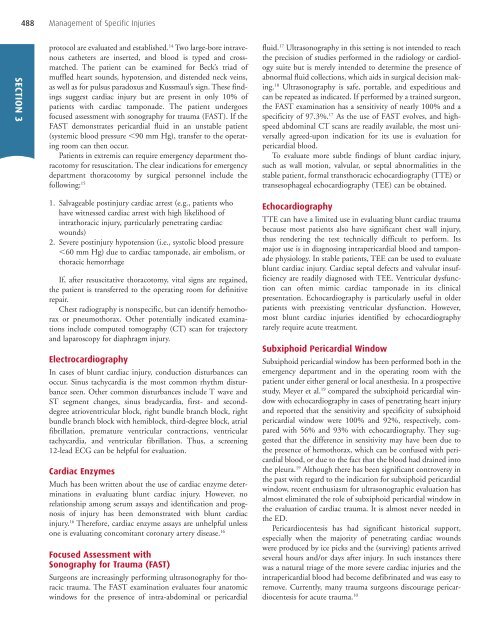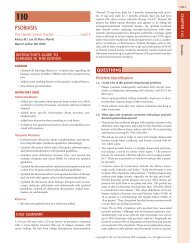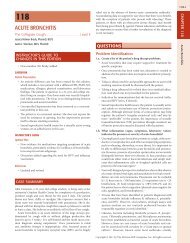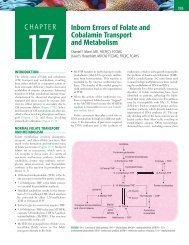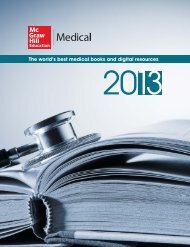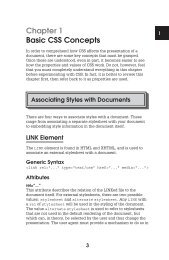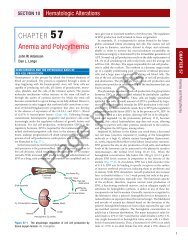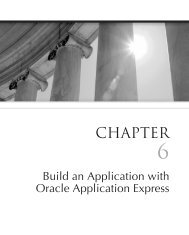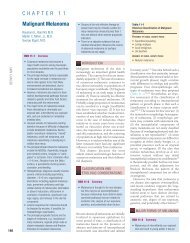Chapter 26 - McGraw-Hill Professional
Chapter 26 - McGraw-Hill Professional
Chapter 26 - McGraw-Hill Professional
Create successful ePaper yourself
Turn your PDF publications into a flip-book with our unique Google optimized e-Paper software.
488 Management of Specific Injuries<br />
SECTION 3 X<br />
protocol are evaluated and established. 14 Two large-bore intravenous<br />
catheters are inserted, and blood is typed and crossmatched.<br />
The patient can be examined for Beck’s triad of<br />
muffled heart sounds, hypotension, and distended neck veins,<br />
as well as for pulsus paradoxus and Kussmaul’s sign. These findings<br />
suggest cardiac injury but are present in only 10% of<br />
patients with cardiac tamponade. The patient undergoes<br />
focused assessment with sonography for trauma (FAST). If the<br />
FAST demonstrates pericardial fluid in an unstable patient<br />
(systemic blood pressure 90 mm Hg), transfer to the operating<br />
room can then occur.<br />
Patients in extremis can require emergency department thoracotomy<br />
for resuscitation. The clear indications for emergency<br />
department thoracotomy by surgical personnel include the<br />
following: 15<br />
fluid. 17 Ultrasonography in this setting is not intended to reach<br />
the precision of studies performed in the radiology or cardiology<br />
suite but is merely intended to determine the presence of<br />
abnormal fluid collections, which aids in surgical decision making.<br />
18 Ultrasonography is safe, portable, and expeditious and<br />
can be repeated as indicated. If performed by a trained surgeon,<br />
the FAST examination has a sensitivity of nearly 100% and a<br />
specificity of 97.3%. 17 As the use of FAST evolves, and highspeed<br />
abdominal CT scans are readily available, the most universally<br />
agreed-upon indication for its use is evaluation for<br />
pericardial blood.<br />
To evaluate more subtle findings of blunt cardiac injury,<br />
such as wall motion, valvular, or septal abnormalities in the<br />
stable patient, formal transthoracic echocardiography (TTE) or<br />
transesophageal echocardiography (TEE) can be obtained.<br />
1. Salvageable postinjury cardiac arrest (e.g., patients who<br />
have witnessed cardiac arrest with high likelihood of<br />
intrathoracic injury, particularly penetrating cardiac<br />
wounds)<br />
2. Severe postinjury hypotension (i.e., systolic blood pressure<br />
60 mm Hg) due to cardiac tamponade, air embolism, or<br />
thoracic hemorrhage<br />
If, after resuscitative thoracotomy, vital signs are regained,<br />
the patient is transferred to the operating room for definitive<br />
repair.<br />
Chest radiography is nonspecific, but can identify hemothorax<br />
or pneumothorax. Other potentially indicated examinations<br />
include computed tomography (CT) scan for trajectory<br />
and laparoscopy for diaphragm injury.<br />
Electrocardiography<br />
In cases of blunt cardiac injury, conduction disturbances can<br />
occur. Sinus tachycardia is the most common rhythm disturbance<br />
seen. Other common disturbances include T wave and<br />
ST segment changes, sinus bradycardia, first- and seconddegree<br />
atrioventricular block, right bundle branch block, right<br />
bundle branch block with hemiblock, third-degree block, atrial<br />
fibrillation, premature ventricular contractions, ventricular<br />
tachycardia, and ventricular fibrillation. Thus, a screening<br />
12-lead ECG can be helpful for evaluation.<br />
Cardiac Enzymes<br />
Much has been written about the use of cardiac enzyme determinations<br />
in evaluating blunt cardiac injury. However, no<br />
relationship among serum assays and identification and prognosis<br />
of injury has been demonstrated with blunt cardiac<br />
injury. 16 Therefore, cardiac enzyme assays are unhelpful unless<br />
one is evaluating concomitant coronary artery disease. 16<br />
Focused Assessment with<br />
Sonography for Trauma (FAST)<br />
Surgeons are increasingly performing ultrasonography for thoracic<br />
trauma. The FAST examination evaluates four anatomic<br />
windows for the presence of intra-abdominal or pericardial<br />
Echocardiography<br />
TTE can have a limited use in evaluating blunt cardiac trauma<br />
because most patients also have significant chest wall injury,<br />
thus rendering the test technically difficult to perform. Its<br />
major use is in diagnosing intrapericardial blood and tamponade<br />
physiology. In stable patients, TEE can be used to evaluate<br />
blunt cardiac injury. Cardiac septal defects and valvular insufficiency<br />
are readily diagnosed with TEE. Ventricular dysfunction<br />
can often mimic cardiac tamponade in its clinical<br />
presentation. Echocardiography is particularly useful in older<br />
patients with preexisting ventricular dysfunction. However,<br />
most blunt cardiac injuries identified by echocardiography<br />
rarely require acute treatment.<br />
Subxiphoid Pericardial Window<br />
Subxiphoid pericardial window has been performed both in the<br />
emergency department and in the operating room with the<br />
patient under either general or local anesthesia. In a prospective<br />
study, Meyer et al. 19 compared the subxiphoid pericardial window<br />
with echocardiography in cases of penetrating heart injury<br />
and reported that the sensitivity and specificity of subxiphoid<br />
pericardial window were 100% and 92%, respectively, compared<br />
with 56% and 93% with echocardiography. They suggested<br />
that the difference in sensitivity may have been due to<br />
the presence of hemothorax, which can be confused with pericardial<br />
blood, or due to the fact that the blood had drained into<br />
the pleura. 19 Although there has been significant controversy in<br />
the past with regard to the indication for subxiphoid pericardial<br />
window, recent enthusiasm for ultrasonographic evaluation has<br />
almost eliminated the role of subxiphoid pericardial window in<br />
the evaluation of cardiac trauma. It is almost never needed in<br />
the ED.<br />
Pericardiocentesis has had significant historical support,<br />
especially when the majority of penetrating cardiac wounds<br />
were produced by ice picks and the (surviving) patients arrived<br />
several hours and/or days after injury. In such instances there<br />
was a natural triage of the more severe cardiac injuries and the<br />
intrapericardial blood had become defibrinated and was easy to<br />
remove. Currently, many trauma surgeons discourage pericardiocentesis<br />
for acute trauma. 10


